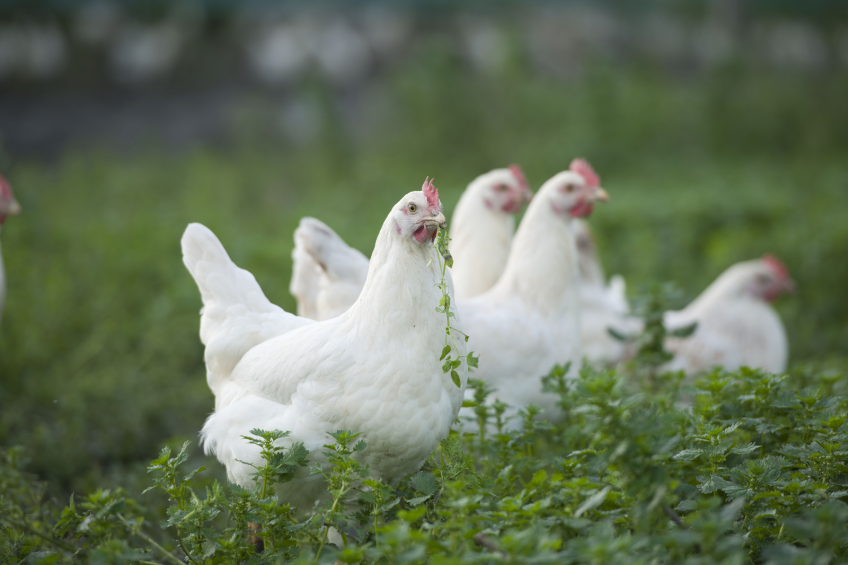Ways to integrate poultry with pasture species

With the right tools for alternative feeding systems and pasture enrichment, farmers can successfully incorporate poultry into free-range, multi-species pasture or agroforestry production, based on the results of a USDA-ARS Arkansas study.
The Southern Sustainable Agriculture Research & Education (SSARE)-funded project (LS10-226), “Integrating Free Range Poultry with Ruminant and Agroforestry Production in a Systems Approach,” looked at the various ways pasture can be used as a resource in ecological poultry production.
“In ecological poultry production, using a pasture resource effectively can be key to sustainability. You can use the pasture to its full benefits, but the challenge for farmers is to know how to do it,” said Anne Fanatico, an assistant professor at Appalachian State University in North Carolina.
Alternative feeding systems, parasite control and pasture enrichment
Fanatico and her colleagues looked at alternative feeding systems, parasite control and pasture enrichment. “When integrating poultry with other animal species on pasture or agroforestry systems, high-quality forage can be an important source of nutrients for poultry, but the birds also need a concentrated source of feed, particularly energy feed because they do not ferment fiber like ruminant animals do,” said Fanatico.
Free-choice feed and choice feeding
The researchers studied two feeding systems: free-choice feed and choice feeding as an alternative to fully formulated diets that can make use of the pasture resource. In free-choice feeding, also known as “cafeteria-feeding”, feedstuffs are offered separately to birds, such as grains, protein concentrates, vitamins and mineral sources, so they can self-select a diet suited to their changing needs.”Feed is a high cost, particularly for organic and small-scale producers,” said Fanatico. “Free-choice feeding may offer cost savings, including the use of on-farm ingredients, reduction in feed transportation, and milling costs.”
Fully formulated or free-choice diet
In the study, chickens were randomly assigned one of two treatments: fully formulated or free-choice diet. Researchers found that crude protein was lower in the free-choice diet (13.2 percent) than the fully formulated feed (20.75 percent), and breast yields were high in birds fed the fully formulated diet. However, the free-choice diet was less expensive and final live weights did not differ between the two treatments.
In choice feeding, the birds typically choose between two feeds: a protein concentrate and a grain. “Choice feeding may allow birds raised in relatively open housing with largely uncontrolled environmental conditions to more precisely meet their nutritional requirements by self-selection compared to a fully-formulated diet,” said Fanatico. “Choice feeding may also allow producers to use feed grains produced on their own farms in order to reduce transportation and milling costs.”
In the choice feeding studies, researchers found that birds on a fully formulated diet gained more weight than those on a choice feeding diet. However, feed efficiency in the choice feeding diet was greater and was less expensive. Researchers also studied various forage needs for poultry, such as chicory, soybeans and sericea lespedeza. Forages low in fiber are best for poultry, said Fanatico.
Enrichment of outdoor areas in pasture
In addition to feeding and forage, Fanatico and her colleagues looked at the enrichment of outdoor areas in pasture and agroforestry systems to encourage birds to more actively obtain nutrients, spread manure, and reduce heavy use around the poultry house. “Pasture is an important resource for poultry. What good is it if they don’t use it,” said Fanatico. “So we wanted to look at various ways of drawing them out into the yard by simulating agroforestry structures.” Researchers incorporated enrichment elements such as roosts, screened shelters, branches and other elements to provide shade and protection. They found that birds introduced to pasture with those constructed enrichments foraged more, used the pasture more fully, and moved further away from poultry houses.
Prevalence of parasites
Lastly, researchers studied the prevalence of parasites in both livestock and poultry when integrating free-range poultry with small ruminants, cattle and swine. They found that sericea lespedeza, which is found to be effective in small ruminant parasite control, had little impact on broiler parasites. Also, when evaluating Campylobacter and Salmonella parasites in poultry in integrated cattle and swine systems, findings were mixed.













